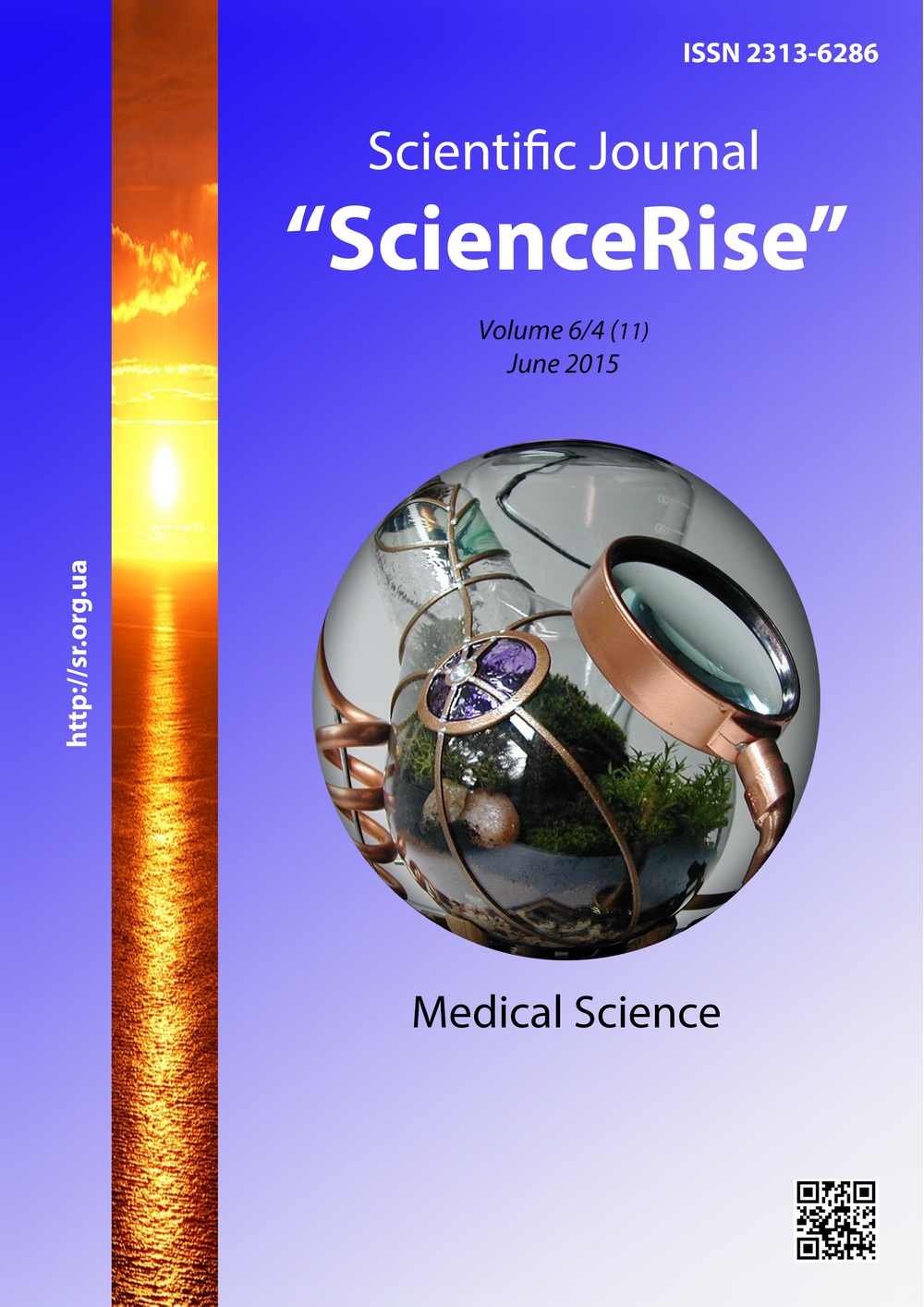Dynamics of cognitive disturbances in rats with acute cerebral ischemia on the background of introduction of 0.9 % solution NaCl
DOI:
https://doi.org/10.15587/2313-8416.2015.45163Keywords:
acute disturbance of cerebral blood circulation, infusion therapy, cognitive functions, 0, 9 % solution of NaClAbstract
For today there are no clear recommendations on infusion therapy at the disease and injuries of brain, and infusion preparations are commonly used empirically. Within the framework of the complex study of an influence of the different infusion remedies on brain at an experimental ischemia of brain, an aim of this work is to investigate how the 0,9 % solution of NaCl influences on the dynamics of cognitive functions and neurological status of the rats with an acute cerebral ischemia at the course medical introduction into an animal organism.
Methods. Experiments were carried out on 60 white rats-males. An acute disturbance of cerebral blood circulation (ADCBC) was modeled by means of the two-sided dressing of internal carotid arteries. The 0,9 % solution of NаСІ was injected intravenously in catheterized thigh vein 2,5 ml/kg 2 times/day (5 ml/kg for a day). The first introduction was carried out in 30 minutes after ADCBC and then every day in 12 hours during 7 days. The control groups consist of intact rats that received 0,9 % NаСІ and animals with a model ischemia without treatment.
Neurological deficiency in animals was defined on the scale stroke-index McGrow C. P. The dynamics of position-finding activity was assessed in experiment “an open field”. An assessment of animal capacity to training and memorization of an aversive stimulus was studied in the test of conditioned response of passive avoidance. The results were processed using the program StatPlus 2009.
Results. The study showed that bilateral carotid occlusion in rats without treatment is followed not only by the high animal lethality but also by the development of a hard neurological symptomatology and then by essential disturbance of mnestic functions in animals that survived during the recovery period of model insult (р<0,01).
The study of lethality dynamics, neurological status, behavioral responses in rats with ADCBC on the model of bilateral carotid occlusion showed that the course therapeutic infusion of 0,9 % solution of NaCl had some advantages relative to the group of the control pathology on indicators of neurological deficiency, orientating and searching activity, capacity to training and memorization.
Conclusions. Infusion therapy with 0,9 % solution of NaCl in rats with the model cerebral ischemia in some degree promotes the renewal of its cognitive functions (р<0,05) relative to the untreated animals. Therapeutic effect of infusion therapy obtained in experiment with isoosmolar 0,9 % solution of NaCl is a reason to study protective actions of infusion preparations of the other groups at an acute disturbance of cerebral blood circulation
References
Varakin, Ju. (2007). Profilaktika insul'tov [Profilaktika insul'tov]. Medicina neotlozhnyh sostojanij, 2 (9), 98–103.
Gusev, E. I. (2001). Ishemija golovnogo mozga [Ishemija golovnogo mozga]. Moscow: Medicina, 328.
Kaplan, P. (2003). Rehabilitation of Stroke [Rehabilitation of Stroke]. London, United Kindom: Butterworth of Heinemann, 180.
Jarosh, A. S. (2014). Sovremennoe sostojanie problemy ostryh narushenij mozgovogo krovoobrashhenija [Sovremennoe sostojanie problemy ostryh narushenij mozgovogo krovoobrashhenija]. Zhurnal Grodnenskogo gosudarstvennogo medicinskogo universiteta, 3 (47), 17–20.
Geyer, J. D., Gomez, C. R. (2009). Stroke. A practical approach [Stroke. A practical approach]. New York, USA: Lippincott Williams & Wilkins, 361.
Karzin, A. V. (2003). Osobennosti infuzionnoj terapii pri ostryh zabolevanijah i povrezhdenijah golovnogo mozga, soprovozhdajushhihsja vnutricherepnymi krovoizlijanijami [Osobennosti infuzionnoj terapii pri ostryh zabolevanijah i povrezhdenijah golovnogo mozga, soprovozhdajushhihsja vnutricherepnymi krovoizlijanijami]. Nauchno-Issledovatel'skij Institut imeni Sklifosovskogo, Мoscow, 129.
McGraw, C. P. (1977). Experimental Cerebral Infarction Effects of Pentobarbital in Mongolian Gerbils. Archives of Neurology, 34 (6), 334–336. doi: 10.1001/archneur.1977.00500180028006
Buresh, Ja., Bureshova, O., H'juston, D. (1991). Metodiki i osnovnye jeksperimenty po izucheniju mozga i povedenija [Metodiki i osnovnye jeksperimenty po izucheniju mozga i povedenija]. Moscow: Vysshaja shkola, 527.
Golovenko, M. Ja. (2002). Eksperimental'ne vivchennja nootropnoi aktivnostі farmakologіchnih spoluk [Eksperimental'ne vivchennja nootropnoi aktivnostі farmakologіchnih spoluk: metod. rekomendacіi]. Kyiv, Ukraine: DFC MOZ Ukraini, 26.
Downloads
Published
Issue
Section
License
Copyright (c) 2015 Андрій Ігорович Семененко

This work is licensed under a Creative Commons Attribution 4.0 International License.
Our journal abides by the Creative Commons CC BY copyright rights and permissions for open access journals.
Authors, who are published in this journal, agree to the following conditions:
1. The authors reserve the right to authorship of the work and pass the first publication right of this work to the journal under the terms of a Creative Commons CC BY, which allows others to freely distribute the published research with the obligatory reference to the authors of the original work and the first publication of the work in this journal.
2. The authors have the right to conclude separate supplement agreements that relate to non-exclusive work distribution in the form in which it has been published by the journal (for example, to upload the work to the online storage of the journal or publish it as part of a monograph), provided that the reference to the first publication of the work in this journal is included.

